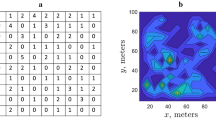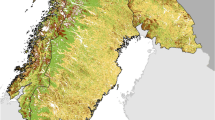Abstract
Humans and climate affect ecosystems and their services1, which may involve continuous and discontinuous transitions from one stable state to another2. Discontinuous transitions are abrupt, irreversible and among the most catastrophic changes of ecosystems identified1. For terrestrial ecosystems, it has been hypothesized that vegetation patchiness could be used as a signature of imminent transitions3,4. Here, we analyse how vegetation patchiness changes in arid ecosystems with different grazing pressures, using both field data and a modelling approach. In the modelling approach, we extrapolated our analysis to even higher grazing pressures to investigate the vegetation patchiness when desertification is imminent. In three arid Mediterranean ecosystems in Spain, Greece and Morocco, we found that the patch-size distribution of the vegetation follows a power law. Using a stochastic cellular automaton model, we show that local positive interactions among plants can explain such power-law distributions. Furthermore, with increasing grazing pressure, the field data revealed consistent deviations from power laws. Increased grazing pressure leads to similar deviations in the model. When grazing was further increased in the model, we found that these deviations always and only occurred close to transition to desert, independent of the type of transition, and regardless of the vegetation cover. Therefore, we propose that patch-size distributions may be a warning signal for the onset of desertification.
This is a preview of subscription content, access via your institution
Access options
Subscribe to this journal
Receive 51 print issues and online access
$199.00 per year
only $3.90 per issue
Buy this article
- Purchase on Springer Link
- Instant access to full article PDF
Prices may be subject to local taxes which are calculated during checkout



Similar content being viewed by others
References
Millennium Ecosystem Assessment. Ecosystems and Human Well-Being: Desertification Synthesis (World Resources Institute, Washington DC, 2005)
Scheffer, M., Carpenter, S., Foley, J. A., Folke, C. & Walker, B. Catastrophic shifts in ecosystems. Nature 413, 591–596 (2001)
Kéfi, S., Rietkerk, M., van Baalen, M. & Loreau, M. Local facilitation, bistability and transitions in arid ecosystems. Theor. Popul. Biol. 71, 367–379 (2007)
Rietkerk, M., Dekker, S. C., de Ruiter, P. C. & van de Koppel, J. Self-organized patchiness and catastrophic shifts in ecosystems. Science 305, 1926–1929 (2004)
Reynolds, J. F. et al. Global desertification: Building a science for dryland development. Science 316, 847–851 (2007)
Aguiar, M. R. & Sala, O. E. Patch structure, dynamics and implications for the functioning of arid ecosystems. Trends Ecol. Evol. 14, 273–277 (1999)
Alados, C. L. et al. Association between competition and facilitation processes and vegetation spatial patterns in alpha steppes. Biol. J. Linn. Soc. 87, 103–113 (2006)
Callaway, R. M. & Walker, L. R. Competition and facilitation: a synthetic approach to interactions in plant communities. Ecology 78, 1958–1965 (1997)
Schlesinger, W. H. et al. Biological feedbacks in global desertification. Science 247, 1043–1048 (1990)
Pugnaire, F. I., Haase, P. & Puigdefabregas, J. Facilitation between higher plant species in a semiarid environment. Ecology 77, 1420–1426 (1996)
Jordano, P., Bascompte, J. & Olesen, J. M. Invariant properties in coevolutionary networks of plant–animal interactions. Ecol. Lett. 6, 69–81 (2003)
Solé, R. V. & Bascompte, J. in Self-organization in Complex Ecosystems Ch. 6 215–262 (Princeton Univ. Press, Princeton, 2006)
Iwasa, Y. in The Geometry of Ecological Interactions. Simplify Ecological Complexity (eds Dieckmann, U., Law, R. & Metz, J. A. J.) 227–251 (Cambridge Univ. Press, Cambridge, 2000)
Noy-Meir, I. Stability of grazing systems: an application of predator–prey graphs. J. Ecol. 63, 459–481 (1975)
Brown, J. H. et al. The fractal nature of nature: power laws, ecological complexity and biodiversity. Phil. Trans. R. Soc. Lond. B 357, 619–626 (2002)
Guichard, F., Halpin, P. M., Allison, G. W., Lubchenco, J. & Menge, B. A. Mussel disturbance dynamics: signatures of oceanographic forcing from local interactions. Am. Nat. 161, 889–904 (2003)
Malamud, B. D., Morein, G. & Turcotte, D. L. Forest fires: an example of self-organized critical behavior. Science 281, 1840–1842 (1998)
Vandermeer, J. & Perfecto, I. A keystone mutualism drives pattern in a power function. Science 311, 1000–1002 (2006)
Venegas, J. G. et al. Self-organized patchiness in asthma as a prelude to catastrophic shifts. Nature 434, 777–782 (2005)
Bak, P., Tang, C. & Wiesenfeld, K. Self-organized criticality. Phys. Rev. A. 38, 364–374 (1988)
Sornette, D. Critical Phenomena in Natural Sciences: Chaos, Fractals, Selforganization and Disorder: Concepts and Tools (Springer, Berlin/Heidelberg, 2004)
Pascual, M. & Guichard, F. Criticality and disturbance in spatial ecological systems. Trends Ecol. Evol. 20, 88–95 (2005)
Schröter, D. et al. Ecosystem service supply and vulnerability to global change in Europe. Science 310, 1333–1337 (2005)
Schabenberger, O. & Pierce, F. J. Contemporary Statistical Models for the Plant and Soil Sciences Ch. 1 1–34 (CRC Press, Boca Raton, 2002)
Ingerson, T. E. & Buvel, R. L. Structure in asynchronous cellular automata. Physica D 10, 59–68 (1984)
Matsuda, H., Ogita, N., Sasaki, A. & Sato, K. Statistical mechanics of population—the lattice Lotka–Volterra model. Prog. Theor. Phys. 88, 1035–1049 (1992)
Kutznetsov, Y. A. & Levitin, V. V. CONTENT: a Multiplatform Environment for Continuation and Bifurcation Analysis of Dynamical Systems (Centrum voor Wiskunde en Informatica, Amsterdam, 1997)
Alados, C. L. et al. Change in plant spatial patterns and diversity along the successional gradient of Mediterranean grazing ecosystems. Ecol. Modell. 180, 523–535 (2004)
Pueyo, Y. & Alados, C. L. Effects of fragmentation, abiotic factors and land use on vegetation recovery in a semi-arid Mediterranean area. Basic Appl. Ecol. 8, 158–170 (2007)
Pascual, M., Roy, M., Guichard, F. & Flierl, G. Cluster size distributions: signatures of self-organization in spatial ecologies. Phil. Trans. R. Soc. Lond. B 357, 657–666 (2002)
Acknowledgements
The data collection was part of the DRASME (Desertification Risk Assessment in Silvopastoral Mediterranean Ecosystems) Collaborative Research Project. DRASME is funded by the EU under the INCO-DC Program. We acknowledge the assistance of M. Vrachnakis, D. Sirkou and K. Iovi in collecting the field data in Greece. The research of S.K. and M.R. is supported by a personal VIDI grant from the Netherlands Organization of Scientific Research/Earth and Life Sciences (NWO-ALW) to M.R. The research of Y.P. is funded by the Secretaría de Estado de Universidades e Investigación of Ministerio de Educación y Ciencia (Spain). The research of P.C.d.R. is supported by the LNV-NL Strategic Research Program “Sustainable spatial development of ecosystems, landscapes and regions”. We are grateful to M. Kéfi for his help with the figures, and to R. C. G. Chaves for commenting on the manuscript.
Author Contributions The data collection was organized and carried out by C.L.A. (Spanish, Greek and Moroccan sites), V.P.P. (Greek site) and A.E. (Moroccan site). Y.P. participated in the data collection in Spain. S.K. conducted the data analyses with help from C.L.A. and Y.P. S.K. performed the numerical simulations and analysis of the model in collaboration with M.R. and P.C.d.R., and wrote the manuscript. M.R. and P.C.d.R. supervised this work and were involved in the writing. All authors discussed the results and commented on the manuscript.
Author information
Authors and Affiliations
Corresponding author
Ethics declarations
Competing interests
Reprints and permissions information is available at www.nature.com/reprints. The authors declare no competing financial interests.
Rights and permissions
About this article
Cite this article
Kéfi, S., Rietkerk, M., Alados, C. et al. Spatial vegetation patterns and imminent desertification in Mediterranean arid ecosystems. Nature 449, 213–217 (2007). https://doi.org/10.1038/nature06111
Received:
Accepted:
Published:
Issue Date:
DOI: https://doi.org/10.1038/nature06111
This article is cited by
-
Spatial vegetation pattern formation and transition of an extended water–plant model with nonlocal or local grazing
Nonlinear Dynamics (2024)
-
Interplay between Livestock Grazing and Aridity on the Ecological and Nutritional Value of Forage in Semi-arid Mediterranean Rangelands (NE Spain)
Environmental Management (2024)
-
Pattern Formation in Mesic Savannas
Bulletin of Mathematical Biology (2024)
-
Atmospheric CO2 forcing on Mediterranean biomes during the past 500 kyrs
Nature Communications (2023)
-
An early warning signal for grassland degradation on the Qinghai-Tibetan Plateau
Nature Communications (2023)
Comments
By submitting a comment you agree to abide by our Terms and Community Guidelines. If you find something abusive or that does not comply with our terms or guidelines please flag it as inappropriate.



